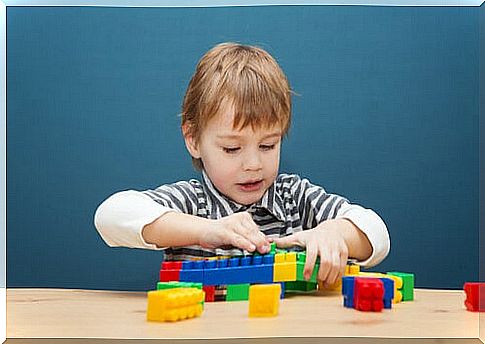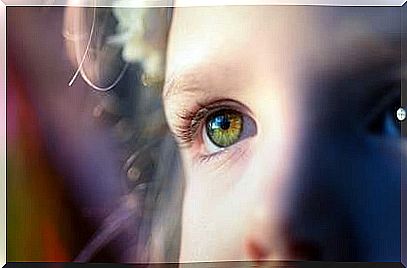Is It True That Children Are Like Sponges?

Children are like ‘sponges’. How many times have we heard that expression? This idea is so ingrained in our collective social unconscious that we rarely question it. With this statement, we assume, for example, that nothing can be as recommendable as transmitting as much information as possible early in the child’s brain.
Now, what is certain about this idea? Is it true that the brain potential of children between 0 and 5 years old is as incredible as they point out? Education professionals know that this idea is reflected in reality with nuances. In fact, there is something that we are all very clear about: a sponge cannot absorb more water than its own capacity allows.
A child’s mind is not an empty cubicle. It is not a closet where one can fill it at will with infinite objects, books and materials. The human brain does not just gobble up the information it receives from its environment: it processes it, shreds it, interprets it and must give it meaning. Learning is also an active process that is directly linked to emotions.
Our children need good foundations from which to consolidate their learning. It is not enough just to fill, you have to create a good foundation based on affection or security. In turn, curiosity, play, enthusiasm, and the joy of interacting with everything that surrounds them must be encouraged. This is undoubtedly the real secret.

Children are like ‘sponges’, an idea that must be reinterpreted
As parents, if there is one thing we want from our children, it is for them to be happy. However, in recent years we also wish something more: that they are well prepared for the demands of the future. Something like this sometimes invites us to wish them to assume certain skills as soon as possible: reading, writing, mathematics, two foreign languages …
Almost without realizing it, in this eagerness to educate potentially brilliant children, what we achieve is to raise hyperstimulated little ones with a level of anxiety greater than that of their parents. They have convinced us for years that children are like sponges and, therefore, we are accelerating stages in their development without knowing that the brain also has its times and, above all, its needs.
A brain with potential but sensitive to overstimulation
It is true that the brain of a child when it comes into the world presents great potential. After birth and up to 7 months, thousands of neurons will move from inside the brain to its frontal lobe. Later, and up to 3 years of age, this organ will have its maximum plasticity threshold.
- Studies, such as the one carried out by Dr. Arthur Toga of the University of Texas and published Cell , for example, even allow us to see the entire brain mapping of a child during the maturation process.
- Through MRIs it has been discovered that up to the age of 10, the glucose consumption of the brain of a child doubles that of adults. And the reason for this is in the energy cost caused by that very high neuronal connection experienced in that first decade of life.
- Now, there is a fact that we must understand. As Dr. Arnold Scheibel, director of the UCLA Brain Research Institute explains , a child’s learning should be a ‘feast’, something festive, never a stressful experience. Thus, when the level of stimulation is excessive, the brain releases cortisol, the stress hormone, something very counterproductive for child development.

Let’s respect times, encourage emotions and allow play
In a society based on immediacy and competitiveness, many parents want their children to assume certain skills as soon as possible. In this way, many little ones end up with schedules more crowded with activities than adults.
Thus, the game has been distorted. It seems that games that do not teach are meaningless, when the main purpose of play in childhood is fun and enjoyment. We have a reflection of this policy in many of those children whom we label as hyperactive. We do not always make our child the brightest and even less so the happiest.
It is true that the brain of our children has great potential, but like any organ in the maturing phase it has its times. It is an impossible task to teach them to read or write if they have not first matured those visual structures that allow them to focus, discriminate and interpret symbols. Nor when they have not worked hand-eye coordination.
Advancing stages is useless if there are no foundations
In Finland, between the ages of 0 and 6, literacy skills are not prioritized. In educational centers other skills are worked on, those that will help a child to build good brain foundations with which, later, to promote learning. But what are those other skills?
- The game.
- Movement, gross motor skills and fine motor skills.
- Social interaction.
- The development and refinement of the senses.
- Emotional intelligence.

To conclude, although it is true that the first decade of a child’s life is key to promoting development, it should never lead to hyperstimulation. We cannot neglect the importance of symbolic play, to enhance their creative spirit, to promote good emotional intelligence, to promote movement, interaction with their environment, curiosity, the pleasure of discovery …
So let’s rephrase the idea that children are like ‘sponges’. Our little ones are ‘people’ who deserve the maximum learning opportunities, as well as our affection and the opportunity to enjoy the best childhood. No pressure, no idealism.









